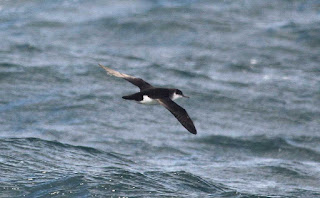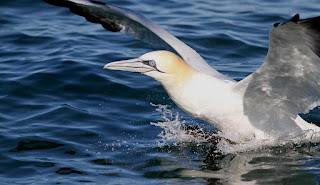It was slightly foggy when we left the dock around 6:26 AM, but it soon cleared up. The pipe dredge working on clearing the channel hadn't made much progress, so we had to make about a seven mile detour through Pamlico Sound to get to the ocean. When we got to Hatteras Inlet, we found Razorbills inside the inlet. When we made it to the ocean, the water was in the high 40s, so things were looking up. Not knowing how extensive this band of cold water was, I headed east to Diamond Shoals and crossed to the north. Numbers of Razorbills increased as we went. We had seen a hundred or so by the time we got across the shoals, as well as a couple of Manx Shearwaters. The first hour north of the shoals, we saw over 400 more Razorbills and we were just getting into it. Between 10:00 and 11:00 I counted 765 Razorbills and that was probably low. We also saw 15 Manx Shearwaters that hour and we were just three or four miles off the beach. Heading eastward, the Razorbills continued in great numbers until we got into slightly warmer water. The water had been about 46 degrees, but when it approached 50, we started to see small flocks of Dovekies buzzing around. We saw about a hundred in thirty minutes, as well as the first few puffins of the day. The water was a little choppy, so we could only see the close puffins, which for the most part were not flying. We kept heading offshore, looking for warmer water and hopefully some Red Phalaropes, and maybe a fulmar. We found the phalaropes and had good looks at dozens on the water. We turned around in about 50 fathoms, where the water was in the mid 60s. There was not a hard change there; it just got rougher. A few minutes later a Black-capped Petrel came zipping up the wake and gave us a good, long look. As we worked into cooler water, we saw more Dovekies, including a few on the water. One of these diminutive birds was snatched up by a Herring Gull, which soon dropped it. When it returned to the surface, it was plucked from the water by a Great Black-backed Gull. Then there was a big melee behind the boat, as more Black-backs fought to get the Dovekie, but in turn lost to a gannet, which choked it down. Sad to see, bur for some reason, I was glad it was a gannet that prevailed over the gulls. Just before 2:30 I glanced out the port side window and something caught my eye. It was the old brown bomber from across the sea. People had also just seen it from the stern. We were in about 20 fathoms, south of Diamond Tower, which I suppose are prime waters for a traveling Great Skua. The bird rushed the gull flock, but soon disappeared. Many saw it, but a few did not, despite a quick turnaround and some instructions. It was just not a close encounter, and this is typical of the Bonxie when we see it here. An hour later, we were about ten miles from the inlet and only seven miles off the beach. Kate was on the stern and started screaming. I figured I knew what was going on and I was right. There was another skua back there raising hell with the gulls. This one also kept some distance, but stayed around a bit longer. From there it was a nice ride back in, with more Razorbills, including a flock of 18 maybe a mile up the sound!
Thanks to everyone who came and to Kate Sutherland and Scott Winton for leading the trip with me.
List of Target / Bonus Birds for Sunday February 24, 2013
Black-capped Petrel one
Manx Shearwater 22 (probably more)
Red Phalarope 200 or more
Iceland Gull one adult (Kumlien's)
Great Skua 2
Razorbill 2000 (fairly close count rounded by less than one percent)
Dovekie 232
Atlantic Puffin 15
We also saw plenty of gulls and gannets, including many Lesser Black-backed Gulls and hundreds of Bonaparte's Gulls. There was a Laughing Gull just inside the inlet. They begin arriving about now. There were many Red-throated Loons miles off the beach, but just a few Common Loons. We saw several Loggerhead Turtles, a couple of Hammerhead Sharks, and many Bottlenose Dolphins. The weather was nice with slight seas and light to moderate northerly winds, but not much sunshine.
Captain Brian Patteson (Photos from February 24, 2013 by Kate Sutherland)
Manx Shearwater
Manx Shearwater
second Great Skua!
Dovekie and victorious Northern Gannet
Razorbill
Atlantic Puffin
Atlantic Puffin
Northern Gannet
Northern Gannet
adult Iceland Gull (Kumlien's Gull)
Lesser Black-backed Gull
Lesser Black-backed Gull
Our faithful flock!






























